
This is a placeholder text
Group text
by Ibrahim on 07 May 2012 - 14:05
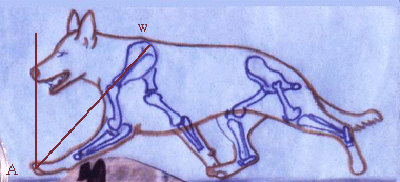
Please note line WA which connects the most far point a well constructed GSD could reach in his front reach and the top mid of the shoulder blade, please note that this line goes exactly through the center of shoulder blade upto the tip of the toes when touching the ground. This line WA is also the resultant length the combination of fore assembly bone could make in a ful reach (shoulder blade +front upper arm + fore leg + pastern + toes).
Let us look at same line in Dingo
.gif)
And let us look at this line on Gina vom Aquamarin who is in my humble opinion one of the best movers ever.
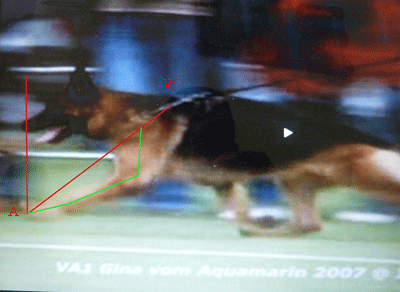
by Ibrahim on 07 May 2012 - 15:05
For those who do not know Gina here is a video which wasn't done in the best way and handler was straining her on the leash but nevertheless her incredible fore-front & fore-under reach is obvious
by Ibrahim on 07 May 2012 - 17:05
Okay I will sum up, answer the question and say few observations, notes and then hear what you have to say, all are welcome to share their opinions.
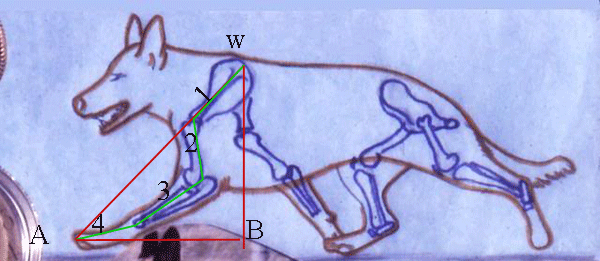
DWBA is a closed trangle, AB is the distance between top of mid point of shoulder blade bone and ground. BA is the distance covered by for leg in a single trot forward and called fore-front reach or simply front reach. Line AW is the resultant distance of the sum up of all the bones in the fore assembly (1,2,3 &4).
The longer line BA is the better the front reach of a dog. What can make line longer? The longer the line WB and or line AW as a result line BA will become longer. Line WB is not our present concern at the moment and it will not be considered temporarily.
I will focus on line AW, this line is the resultant sum lengths of all the fore bones in full reach as it connects the shoulder blade and toes.Therefore the longer the sum of those bones the longer is AW and then BA. To explain how increase in line AW affects line AB here is a diagram, please note that approximately each 2 inches increase in line AW will make 1 inch increase in line AB.
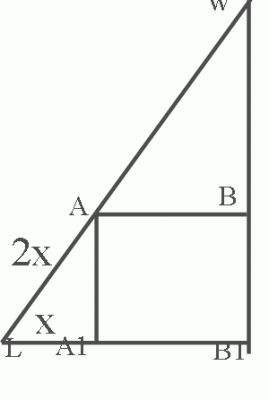

DWBA is a closed trangle, AB is the distance between top of mid point of shoulder blade bone and ground. BA is the distance covered by for leg in a single trot forward and called fore-front reach or simply front reach. Line AW is the resultant distance of the sum up of all the bones in the fore assembly (1,2,3 &4).
The longer line BA is the better the front reach of a dog. What can make line longer? The longer the line WB and or line AW as a result line BA will become longer. Line WB is not our present concern at the moment and it will not be considered temporarily.
I will focus on line AW, this line is the resultant sum lengths of all the fore bones in full reach as it connects the shoulder blade and toes.Therefore the longer the sum of those bones the longer is AW and then BA. To explain how increase in line AW affects line AB here is a diagram, please note that approximately each 2 inches increase in line AW will make 1 inch increase in line AB.

by Ibrahim on 07 May 2012 - 18:05
And to explain how increase in length of each bone affects line AW, shoulder blade is in same direction/almost no deviation from line AW, in other words same line same direction and it is the only bone that has this virtue, therefore each one inch increase in length of shoulder blade results in one inch increse in line AW and hence a half inch increase in front reach approximately. So shoulder blade when lengths of bones is under evaluation has a good positive effect on front reach and proper value should be given to it accordingly when discussing the shoulder (front upper arm & shoulder blade).
Now to the fore leg, note that it runs in a direction further to the outside, any increase in its length will have two effects 1. pushing the toe tip further in direction of line BA (to the outside) and 2. pushing the toe tip in direction of line WA , relatively this is a little bigger effect on resultant distance gained in front reach BA than that of the shoulder blade. Same is in case of the pastern which runs further to the outside direction and has a relatively a little bigger effect on front reach than fore le and accordingly the shoulder blade. If we put in order effect of increase in length of the so far considered bones, it will be in this order
1. Pastern
2. Fore leg
3. Shoulder blade
we continue with the front upper arm length which is more complicated
Now to the fore leg, note that it runs in a direction further to the outside, any increase in its length will have two effects 1. pushing the toe tip further in direction of line BA (to the outside) and 2. pushing the toe tip in direction of line WA , relatively this is a little bigger effect on resultant distance gained in front reach BA than that of the shoulder blade. Same is in case of the pastern which runs further to the outside direction and has a relatively a little bigger effect on front reach than fore le and accordingly the shoulder blade. If we put in order effect of increase in length of the so far considered bones, it will be in this order
1. Pastern
2. Fore leg
3. Shoulder blade
we continue with the front upper arm length which is more complicated
by Ibrahim on 07 May 2012 - 19:05
Before I go to the front upper arm I have to stress one point about the line WA, this line is a sort of balance that whatever we play with the lengths and angles of fore assembly bones it will always be there when stretching the fore leg forward running from the top mid point of the shoulder blade through its axis to the toe tips, it will always be like that in full reach, it is a sort of balance or compulsory result of various front angles, bone lengths, inter-proportions etc. resultant direction will always run from top mid of shoulder blade through its axis to tip of mid foot/toe.
by Ibrahim on 07 May 2012 - 20:05
Now in the same mathematics & logic as stated above, looking at front upper arm we find its direction is away from that of line WA, so one might wrongly deduct that increase in its length will have adverse effect on distance WA and therefore decrease the front reach BA. No it is not like that, as a matter of fact shoulder blade and front upper arm are themselves are a smaller assemble inside a bigger one and any increase in front upper arm will only be adjusted for within the smaller assemble which means the effect of increase in length of front upper arm will push upward in the direction of the front upper arm causing the inter joint between them to point more upward and therefore pushing the line WA to further to the outside by increasing the angle at point W.
Keeping in mind that at the end line WA will always connect points W & A as explained earler, therefore line WA increases and accordingly front reach BA increases.
We should never forget the importance of proportions between the various fore assembly bones, these proportions are crucial for balance and proper effective movement.
when increasing the length of front upper arm without control of desirable proportions we end up with the lifting up of the fore leg of the dog in gaiting to compensate for higher directing of flowing movement force from top of shoulder blade to toe tips, provided also this causes excess undesirable movement in the shoulder blade, I don't claim that is the only reason of this evident lifting up of fore leg in gaiting but it is associated with improper proportions.
For further understanding of whar I called the smaller assembly (the shoulder) please refer to Mr. Donald's paper
http://www.gsdcouncilaustralia.org/louis_donald_article.pdf
One more note the effect of increase in front upper arm to a certain limit is approximately eguvalent to that of the shoulder blade but less than that of pastern and fore leg.
Keeping in mind that at the end line WA will always connect points W & A as explained earler, therefore line WA increases and accordingly front reach BA increases.
We should never forget the importance of proportions between the various fore assembly bones, these proportions are crucial for balance and proper effective movement.
when increasing the length of front upper arm without control of desirable proportions we end up with the lifting up of the fore leg of the dog in gaiting to compensate for higher directing of flowing movement force from top of shoulder blade to toe tips, provided also this causes excess undesirable movement in the shoulder blade, I don't claim that is the only reason of this evident lifting up of fore leg in gaiting but it is associated with improper proportions.
For further understanding of whar I called the smaller assembly (the shoulder) please refer to Mr. Donald's paper
http://www.gsdcouncilaustralia.org/louis_donald_article.pdf
One more note the effect of increase in front upper arm to a certain limit is approximately eguvalent to that of the shoulder blade but less than that of pastern and fore leg.
by Ibrahim on 07 May 2012 - 21:05
At last to answer the question: One dog has forelegs that are at a ratio of 45% of the dogs height, the other has a shoulder that is of correct length but set at 50 degrees and the other has an upperarm that is the correct lenght but set at 60 degrees. Place 1st to 3rd?
With the consideration to bettering the front reach and effective trot I shall place:
1. The one that has an upper arm of correct length but set at 60 degrees
2. The one that has a shoulder blade of correct length but set at 50 degrees
3. The dog that has fore legs of 45% of its height as the 10 % decrease will shorten the front reach tremendously.
Provided I watch the trot of the second one very closely to make sure he does not lift up his for leg excessively making his trot non-efficient. If I get 2/3 in correct positions to each other I will consider it a pass
All are welcome to share
Ibrahim
Thanks Mr. Donald for the nice exercise
With the consideration to bettering the front reach and effective trot I shall place:
1. The one that has an upper arm of correct length but set at 60 degrees
2. The one that has a shoulder blade of correct length but set at 50 degrees
3. The dog that has fore legs of 45% of its height as the 10 % decrease will shorten the front reach tremendously.
Provided I watch the trot of the second one very closely to make sure he does not lift up his for leg excessively making his trot non-efficient. If I get 2/3 in correct positions to each other I will consider it a pass
All are welcome to share
Ibrahim
Thanks Mr. Donald for the nice exercise
by Ibrahim on 08 May 2012 - 05:05
Just to complete the picture of my understanding of the front assembly of the GSD I feel I need to add a little more. It is not actually necessary for each and every one to analyze various aspects scientifically, each one of us and I'm included shapes info and facts in the best way for him/her to digest and maybe that's what I've been doing in this thread so far. for a beginner it is vital that one pays close attention to pieces of info that come from trustworthy sources of respectful background in the GSD world as these are what I like to think of as golden tips or secret keys. I remember when few of the members here on the board helped me to understand structure I got many secret keys as gifts, I knew their value and appreciated them, some I could think of, analyze and put to test and some remained relatively teasing. One of those was what Mr. Donald described as the center of gravity, the line that comes from top mid point of the shoulder blade then passes through the joint between fore leg/front upper arm to pastern joint and this line is vertical. In the very beginning it was brought to my attention by Rik but it remained a teasing one till I read Mr. Donald's paper.
Today when I look at the front assembly I first look at this line, if it looks good then the dog's front is balanced and it is worth going to other parts and issues, but if it's not then the dog has a serious problem whatever one might think he has good other details.
This is an ideal fore assembly balance in my opinion
.gif)
Today when I look at the front assembly I first look at this line, if it looks good then the dog's front is balanced and it is worth going to other parts and issues, but if it's not then the dog has a serious problem whatever one might think he has good other details.
This is an ideal fore assembly balance in my opinion
.gif)
by Ibrahim on 08 May 2012 - 05:05
I had this dog and I didn't leave a single bone accessible without feeling it with my fingers many times repeatedly.
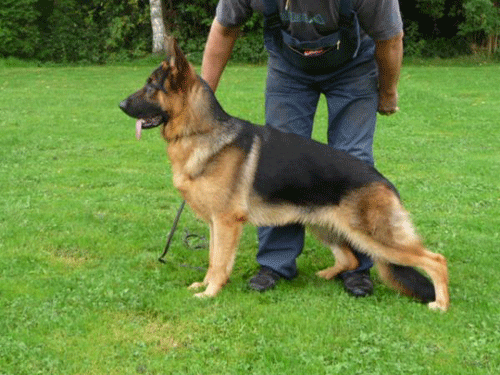
No matter how I tried to teach and make him stand with his feet under his shoulder I couldn't, he would always change to above position which I didn't see correct, it went on till I realized he had a problem, his fore assembly is not in good balance. If you forget about the fore leg and just look at the shoulder, it's a beautiful one but looking again and seeing how his fore leg fits in made me depressed. I know exactly where the top mid point of his shoulder blade and I can represent the above mentioned line to a good correctness like this in the blue line.
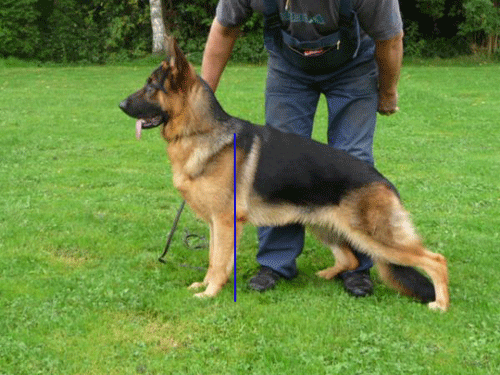
Please see how it passes way back from his pastern joint.
And going back in my try to understand why Dingo had such a good gaiting, one of the reasons is I believe he had perfect blalanced fore assembly.
(1).gif)

No matter how I tried to teach and make him stand with his feet under his shoulder I couldn't, he would always change to above position which I didn't see correct, it went on till I realized he had a problem, his fore assembly is not in good balance. If you forget about the fore leg and just look at the shoulder, it's a beautiful one but looking again and seeing how his fore leg fits in made me depressed. I know exactly where the top mid point of his shoulder blade and I can represent the above mentioned line to a good correctness like this in the blue line.

Please see how it passes way back from his pastern joint.
And going back in my try to understand why Dingo had such a good gaiting, one of the reasons is I believe he had perfect blalanced fore assembly.
(1).gif)
by Ibrahim on 08 May 2012 - 10:05
At last it is all about good, very good or excellent balance. We usually hear well balanced dog, very good constructed dog etc etc. Balance comes from correct proportions, and that is why it is wise to think of of bones in proportion to other bones and each bone in proportion to total bones in a seperate unit/part. Importance starts from total balance and then to balance within each part of the dog.
I will list them in descending order as I see their importance, but each might put them in a different sequence.
1. All over balance: a. Head part & neck b. chest and fore c. mid part d. rear
2. Bones size and strength (including head) to total frame.
3. Height to length
4. Chest depth to height
5. Fore to rear angulations
And then each part's internal proportions is studied seperately, for the fore assembly here is their importance to me:
1. That blue line, without it no balance and therefore nothing very else that is very good in the fore assembly means anything
2. Shoulder blade lay, without it no correct shoulder and no correct fore, good front reach starts from there.
3. Proportions: a. fore leg to height b. shoulder blade to front upper arm c. front upper arm to fore leg c. pastern to fore leg.
4. Angle of fore arm
5. angle of pastern
Going back to Dingo he gets very good for all and each of the above
and maybe that is the most important answer to why he had such a grait trot.
Thanks for bearing with me.
I will list them in descending order as I see their importance, but each might put them in a different sequence.
1. All over balance: a. Head part & neck b. chest and fore c. mid part d. rear
2. Bones size and strength (including head) to total frame.
3. Height to length
4. Chest depth to height
5. Fore to rear angulations
And then each part's internal proportions is studied seperately, for the fore assembly here is their importance to me:
1. That blue line, without it no balance and therefore nothing very else that is very good in the fore assembly means anything
2. Shoulder blade lay, without it no correct shoulder and no correct fore, good front reach starts from there.
3. Proportions: a. fore leg to height b. shoulder blade to front upper arm c. front upper arm to fore leg c. pastern to fore leg.
4. Angle of fore arm
5. angle of pastern
Going back to Dingo he gets very good for all and each of the above
and maybe that is the most important answer to why he had such a grait trot.
Thanks for bearing with me.
Contact information Disclaimer Privacy Statement Copyright Information Terms of Service Cookie policy ↑ Back to top





